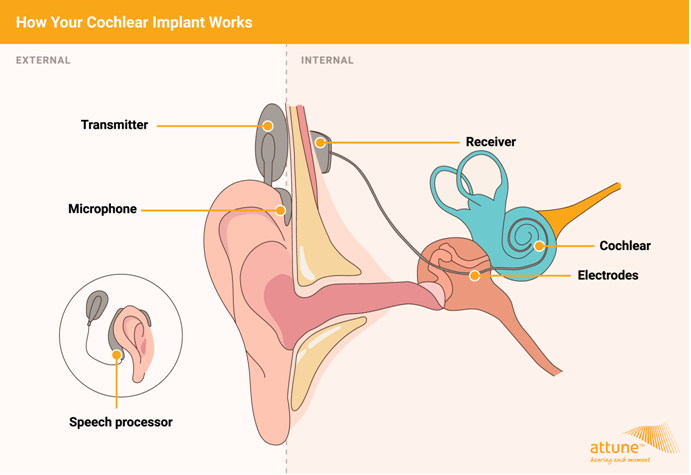Cochlear implants and hearing aids both provide the same function. However, they are still quite different hearing devices. So, what’s the difference? Cochlear implants are surgically implanted into the ear and cannot be removed. Hearing aids, on the other hand, are removable.
Let's dive into the details.
Hearing Aid
First of all, unlike cochlear implants, hearing aids are removable. They are small electronic devices designed to amplify sound going into the ear. They can be taken in and out of the ear canal by the user. They work best for both children and adults who have mild to moderate hearing loss.
The device has a microphone, a computer chip that amplifies and processes sound, a speaker, and battery. The amplified sound is sent directly to the inner ear for translation to electrical impulses transmitted to the brain.
Hearing aids are classified into two categories; in-the-ear and behind-the-ear models. The models are available in all shapes, styles, and sizes.

Cochlear Implant
Cochlear implants are similar to hearing aids but are surgically implanted by a medical professional. The complex medical devices bypass the damaged portion of the inner ear to stimulate the auditory nerve directly. The device does not restore hearing; instead, it provides a sensation of sound for those who are deaf or have profound hearing loss.
Cochlear implants have two parts; internal and external.
- The external part comprises a microphone, speech processor and transmitter. It is positioned outside the ear.
- The internal part consists of a receiver implanted inside the skin behind the ear with one or more electrodes implanted deep into the inner ear.
A wire links the microphone to the speech processor, which is positioned outside the ear over the receiver that is in the skin. A magnet connects the external and internal parts.
Sound gathers by the microphone, and the speech processor is transmitted to the receiver that converts it to electric pulses and dispatches the electrodes. The electrodes stimulate the auditory nerve; the brain receives a signal to process the sound.
Before an implant surgery is done, the patient must undergo an audiological and psychological evaluation, medical exam and imaging studies. Patients and their loved ones undergo counselling about the device, its performance and limitations.
After the surgical site has healed, the recipient returns to have the outer part fitted, and the device
activated and programmed.
Which One Is Right for You?
Only a medical professional can evaluate your hearing and determine which hearing device is suitable for you. If you are having trouble with your hearing, schedule an appointment to have a hearing test with one of our audiologists at Attune. Visit our website to learn more about hearing aids.